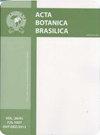An integrative study of Pannaria hookeri (Ascomycota lichenized) from Argentina and the update of the taxon circumscription based on specimens from the Northern and Southern Hemispheres
IF 1.1
4区 生物学
Q4 PLANT SCIENCES
引用次数: 0
Abstract
Pannaria hookeri (Borrer ex Sm.) Nyl. is reported as a bipolar cyanolichen that occurs in more than twenty countries in both Hemispheres. In the Northern Hemisphere, a minor variation is attributed to the species, whereas larger morphological and chemical variations have been reported in specimens from the Southern Hemisphere. Six P. hookeri DNA sequences are available in GenBank, and only one (from Australia) is associated with a published morphological description. In this study, we performed a preliminary phylogenetic analysis including seven nuITS and mtSSU sequences from eight specimens collected in south Argentina. In addition, we provide an update of the taxon circumscription based on 50 specimens from 13 countries. Here, the molecular analyses revealed a well-supported monophyletic group formed by the P. hookeri sequences from Argentina, Australia, Norway and USA (Alaska). Regarding the morphological and anatomical characteristics, the Southern Hemisphere specimens did not present the historical reported variations, resulting in the proposition of a concise species description that accomplishes most of P. hookeri known geographical distribution.阿根廷地衣子囊菌属(Pannaria hookeri)的综合研究及基于南北半球标本的分类群划分更新
帕纳利亚·胡克里(Borrer ex Sm.)Nyl。据报道,它是一种双相蓝藻,在两个半球的20多个国家都有发生。在北半球,该物种的变异较小,而在南半球的标本中报告了较大的形态和化学变异。在GenBank中有6个P. hookeri DNA序列,只有一个(来自澳大利亚)与已发表的形态描述有关。在这项研究中,我们对阿根廷南部采集的8个标本进行了初步的系统发育分析,包括7个nuITS和mtSSU序列。此外,我们还对来自13个国家的50个标本进行了分类群划分的更新。在这里,分子分析显示了一个由阿根廷、澳大利亚、挪威和美国(阿拉斯加)的P. hookeri序列形成的良好支持的单系群。在形态学和解剖学特征方面,南半球标本没有呈现历史报道的变异,因此提出了一个简明的物种描述,完成了大部分已知的hookeri地理分布。
本文章由计算机程序翻译,如有差异,请以英文原文为准。
求助全文
约1分钟内获得全文
求助全文
来源期刊

Acta Botanica Brasilica
PLANT SCIENCES-
CiteScore
2.30
自引率
9.10%
发文量
32
审稿时长
6-12 weeks
期刊介绍:
Experimental, theoretical and applied papers on all aspects of plant (including algae) and fungi biology are welcome. The submitted manuscript or its essential content must not have been published previously or be under consideration for publication elsewhere. Contributions should be substantial, written in high-quality English and show general interest. We expect that the submitted manuscript presents a great novelty in Botany, and this should attract a wide audience. Considering this, case studies are only considered if the narrative and implications are provided to be of general interest. Thus, manuscripts that report aspects of local interest are discouraged unless the implications of the findings are wide-reaching. Manuscripts with agronomic subjects are expected to contain a substantial amount of basic plant biology. Please see below some details for specific area.
 求助内容:
求助内容: 应助结果提醒方式:
应助结果提醒方式:


